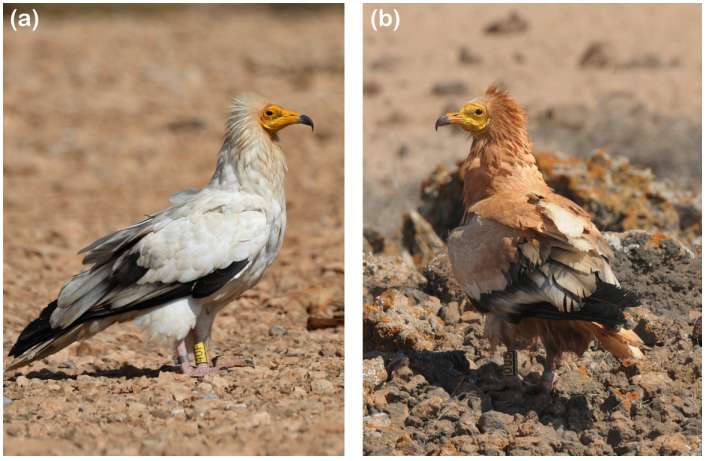May 16, 2017 report
Egyptian vultures found to engage in puzzling cosmetic mud bathing rituals

(Phys.org)—A trio of researchers working at the Doñana Biological Station in Spain has found that Egyptian vultures living in the Canary Islands dip their head, neck and chest in red soil to color themselves. In their paper published in in the journal Ecology, Thijs van Overveld, Manuel de la Riva and José Antonio Donázar describe their observations, a small experiment they conducted, and offer some opinions regarding the reason for the unique behavior of the birds.
Scientists have been studying plants and animals living in the Canary Islands for some time, one species that has been studied extensively is the Egyptian vulture—most that live on the islands have been banded to aid in tracking and telling them apart. As part of the study of the vultures, it has been noted that most if not all of them sport artificially induced reddish coloring of their feathers for periods of time, though until now, the behavior that leads to such coloring has not been studied. In this new effort, the researchers watched and filmed the birds and also conducted a small experiment to learn more about the source of the coloring and why it occurs.
In watching the birds, both live and on tape, the researchers found that the source was red soil in water. The birds would slide their heads around in the red mud, then their necks and even their chests. That left the normally white feathers tinted red. The researchers found birds of nearly all ages and both genders engaged in the coloring ritual but found no behavior that might explain why they do it. To learn more about whether it was mud bathing or simply mushing about in a bath of sorts, the researchers placed bowls of water near one another in a spot frequented by the birds. One of the bowls was filled with fresh clean and clear water while the other had been tinted with red soil. They report that 18 of 91 birds that visited the bowls preferred the one with tinted water while just one went for the clean bath.
The researchers suggest it is possible that the soil serves a hygienic or functional purpose, such as keeping bacteria or bugs at bay, but clearly believe it is more likely a means of communication, noting that the vultures are very social creatures.
More information: Thijs van Overveld et al. Cosmetic coloration in Egyptian vultures: Mud bathing as a tool for social communication?, Ecology (2017). DOI: 10.1002/ecy.1840
via Newscientist
Journal information: Ecology
© 2017 Phys.org


















